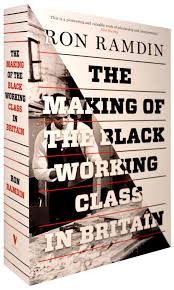The making of the black working class in Britain By RON RAMDIN (Aldershot, Gower, 1987). 626pp. £35.00
Any post-war history of black people in Britain has got to be a history of the black working class: a black middle class as such is only now emerging. Equally, any post-war history of the British labour movement has got to include the signal contribution of black workers to that movement. To look at the chronicles of the movement, however, one would think that the black worker had not existed at all.
Ron Ramdin in charting that presence, in voluminous detail, has made good that implausible lacuna. Others before him, like Shyllon and Walvin, have dipped their toe into the earlier history of black people in Britain – and more recently Peter Fryer has, with meticulous research into primary sources, spanned the half millennium stretching from the Tudors to the second Elizabeth. But his coverage of the post war era is compressed into thirty-two pages of the book. Ramdin, though going over some of the same ground as Fryer, devotes almost three-quarters of his tome to the post-war years when a black working class qua class did begin to take shape.
The size of the book alone bears witness to the amount of work that has gone into it. But it is only when one begins to read it that one becomes aware of the spade work that Ramdin had to do — albeit from secondary sources – in gathering and garnering and sifting and sieving the literature on the subject. In that sense, the book is a pioneering work, a guide to the literature if nothing else, a reference point from which all future researchers can take off, in all sorts of directions, and thereby amplify the historiography of blacks in Britain – in terms now perhaps of the specific areas in which they lived and worked and struggled and contributed to social change. For history is now and in England (pace Eliot) — and without a knowledge of that history there is no struggle.
Ramdin’s book, that is, has the makings of the making of the black working class in Britain – and that is achievement enough – but the making it isn’t, and the allusion to Thompson, alas, is vainglorious.
If the book was to have lived up to its title it would have had to go beyond the accumulation of empirical data to analysis and conceptualisation. It would have needed at least to show how racism, in the labour movement in particular, shaped the making of the black workforce into an instrument of radical working-class protest and ex posed, in the process, the ‘rigidification’ of the trade union bureaucracy and the irrelevance of a self-serving trade union leadership to the working-class movement as a whole. And it would have needed to show therein that the making of the black working class was an integral part of and intrinsic to the making of the British working class as a whole, and that in betraying the most radical section of the class – at Grunwick — the TUC had learned to betray its own radicalism long before it turn ed to betray the miners and the printers. It might also have indicated — as a footnote to labour history – how the policing of the black communities in the 1960s and 1970s had set the mode for the policing of the working class in the 1980s.
But even if one forgives the author for his misleading title, one cannot easily forgive him, a black historian, for the cavalier way in which he has played around with the names of individuals and organisations. Ajoy Ghose, for instance, becomes Ahoy (and not necessarily because his forefathers might well have been lascar seamen), Abhimanyu Manchan da for no reason at all is re-christened Amanyu, RAAS (Racial Adjust ment Action Society) becomes RANS (a repeated Japanese film?), Subhas Chandra Bose goes as Subash Chandrabose and is listed under C in the index which also boasts of a Dr J. Nyerene (presumably of Tan zania) and I myself am encumbered with an extra initial, V, in the bibliography. And to cap it all, an opening quote on the first page of the book makes nonsense of Marx by having him say ‘Labour with a black skin cannot emancipate itself where labour with a black skin is branded’ – whereas it should read ‘Labour with a white skin … ‘. In any writer such mistakes (of proof-reading or otherwise) must be held to be culpable, but in someone who works for the British Library these are mortal sins.

